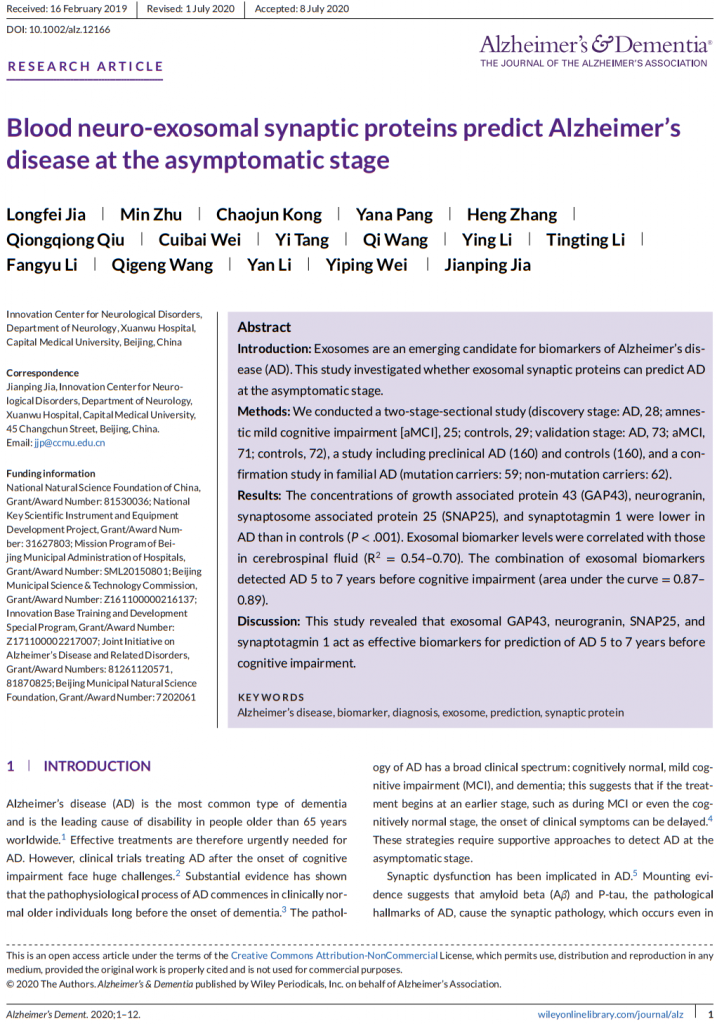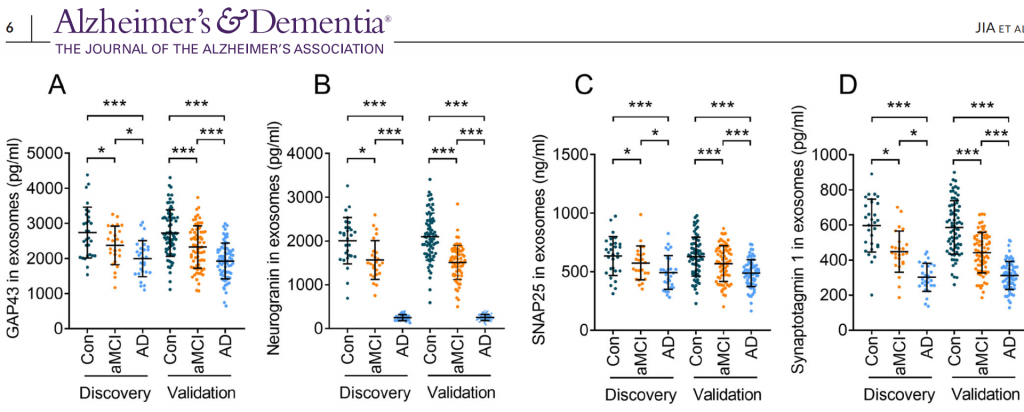In August 2020, Professor Jianping Jia’s team from Xuanwu Hospital published an online article entitled “Blood neuro-exosomal synaptic proteins predict Alzheimer’s disease at the asymptomatic stage” in Alzheimer’s & Dementia (IF: 17.127).It is the first report in the world that a biomarker that can predict Alzheimer’s disease (AD) is found in peripheral blood 5 to 7 years before the onset of symptoms, with an accuracy rate of 87% to 89%.The achievement lay the foundation for early intervention for AD.The first author of the article is Longfei Jia , deputy chief physician of Xuanwu Hospital of Capital Medical University, and the corresponding author is Professor Jianping Jia .

Although AD has become one of the diseases that seriously endanger the health and quality of life of the elderly in the world, there is no effective drug to cure it. Many clinical trials of AD drugs have failed, and the main reason may be that the subjects are at a relatively late stage of disease. If patients are intervened in the early or even asymptomatic stage of AD, the appearance of clinical symptoms may be delayed. Therefore, it is urgent to diagnose the early or even asymptomatic stage of AD. This will also be a new way of preventing and treating AD.
The study included a total of 739 subjects, and was divided into two stages: discovery and verification of exosomal synapse proteins and establishment and verification of prediction models.
Part I
In order to explore the biomarkers for early diagnosis of AD, Professor Jianping Jia’s team conducted a two-phase cross-sectional study, and found that the exosomal concentrations of GAP43, neurogranin, SNAP25,
and synaptotagmin 1 in the AD group were significantly lower than
those in the control group (Figure 1), and the exosomal biomarker levels were correlated with those in cerebrospinal fluid.

Part II
To further validate the predictive power of these exosomes synapsin asymptomatic phase of the AD, Professor Jianping Jia’s team recruited subjects from the longitudinal study started 10 years ago, followed up people with normal cognitive function 5-7 years ago, and established a prediction model to predict the incidence of this population. Through ROC curve and ridge regression analysis, exosomal biomarkers have a high efficiency to reflect the pathological changes of the brain (area under the curve: 0.87-0.89), which can be used to assist in the diagnosis of AD. Subsequently, the prediction model was further validated in the Familial AD (Familial AD, FAD) cohort. The combined detection of these exosomal synaptic proteins can predict AD 5 to 7 years before the onset of cognitive impairment, which is of milestone significance for changing the current dilemma of AD treatment.
This study was supported by the Key Project of the National Natural Science Foundation of China (81530036); the National Key Scientific Instrument and Equipment Development Project (31627803);
Mission Program of Beijing Municipal Administration of Hospitals (SML20150801); Beijing Scholars Program; Beijing Brain Initiative from Beijing Municipal Science & Technology Commission
(Z161100000216137); Innovation Base Training and Development
Special Program (Z171100002217007); CHINA-CANADA Joint Initiative on Alzheimer’s Disease and Related Disorders (81261120571);
Project for Outstanding Doctor with Combined Ability of Western and Chinese Medicine, National Natural Science Foundation of
China (81870825); and Beijing Municipal Natural Science Foundation
(7202061).
